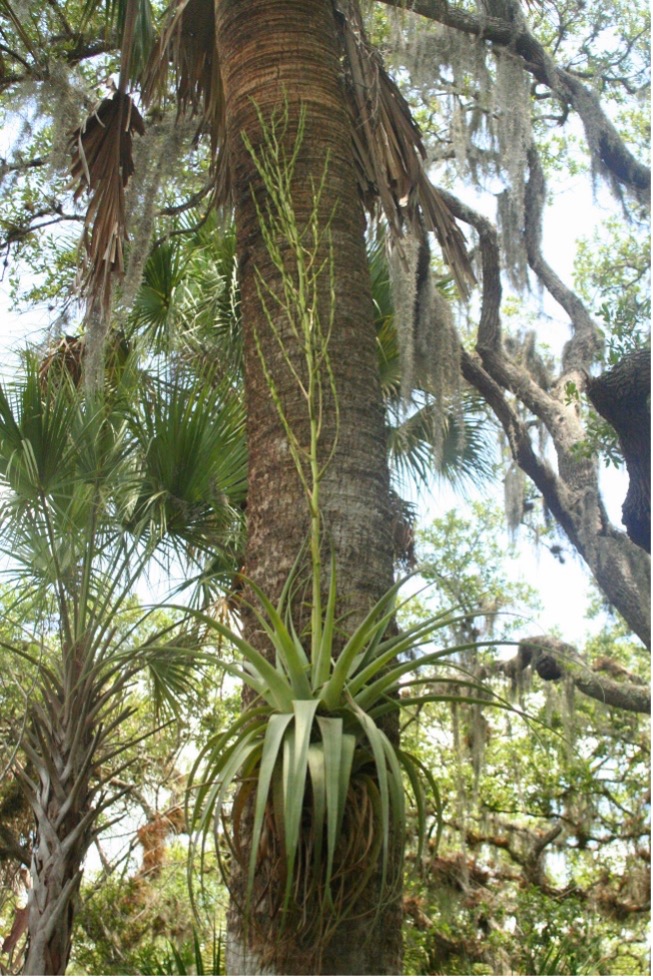For the past 40 years, an invasive weevil, Metamasius callizona, has been attacking the native bromeliads in Florida (Frank and Cave, 2005). This weevil prefers tank-forming bromeliads to lay its eggs, which then develop into larvae that grow by eating the center of each plant and producing a pupal chamber where the weevil larvae then go through metamorphosis (Cooper et al., 2014).
The giant airplant, Tillandsia utriculata, is one bromeliad species that has experienced a significant decline in population numbers throughout the state due to these weevil attacks. Tillandsia utriculata does not produce vegetative offsets (pups) and may take nearly a decade to become large enough to produce an inflorescence. This means that any weevil attacks to T. utriculata individuals not only kill that individual plant, but also greatly reduce natural recruitment rates as the plants are killed before they can flower and set seed.

Figure 1. The Mexican bromeliad weevil (Metamasius callizona) taken from a plant in Manatee County, FL. (photo by Bruce Holst)
Previous studies have shown that M. callizona displays a feeding preference when faced with a choice between Mesoamerican individuals of T. utriculata vs. Florida individuals, selecting the Florida individuals due to increased polysaccharide contents. Furthermore, there are clear morphological differences between Mesoamerican T. utriculata and Florida T. utriculata, thereby suggesting that populations of T. utriculata in Florida may be a distinct species (Pinzón et al., 2016, 2019).
This presents two questions:
1) Are T. utriculata from Florida a distinct species?
2) Is there a genetic or geographical pattern to the weevil attacks on Florida T. utriculata, or is this a random event?

Figure 2. The giant airplant (Tillandsia utriculata) growing on a palm tree in southwestern Florida. (photo by Bruce Holst)
To address these questions, researchers at Selby Gardens are using advanced molecular techniques to investigate the phylogenetic relationships of T. utriculata individuals throughout the species’ geographic range and to examine patterns of population genetic structure in the state of Florida. This project is still in the early stages, and researchers are working to collect tissue and develop the necessary working protocols for the molecular analyses needed to address the questions stated above.
In addition to addressing these important evolutionary and ecological questions, this project will provide up-to-date information regarding the distribution of both T. utriculata and M. callizona in Florida, the latter of which has sparse locality data on record. Through the Selby Gardens EcoFlora Project, which documents epiphytes using the iNaturalist platform, we are reaching out to the greater community by requesting the assistance of citizen scientists in documenting the distribution of the weevil and its trail of damage. By combining occurrence records for both species, we can paint a better picture of the distribution and movement of the weevil over time and examine recovery rates of T. utriculata in those decimated areas.
We are grateful for a generous donation to help conduct this research.
For more information, visit our project pages on the iNaturalist website or write to botany@selby.org. Please sign into our projects on iNaturalist and help document the distribution of both the giant airplant and the Mexican weevil.
Epiphytes of the United States and Canada (for Tillandsia utriculata): https://www.inaturalist.org/projects/epiflora-of-the-united-states-and-canada
Mexican bromeliad weevil: https://www.inaturalist.org/taxa/510263-Metamasius-callizona
Cited Resources
Cooper, T., J. H. Frank, and R. Cave. 2014. Loss of phytotelmata due to an invasive bromeliad-eating weevil and its potential effects on faunal diversity and biogeochemical cycles. Acta Oecologica 54: 51–56.
Frank, H., and R. Cave. 2005. Metamasius callizona is destroying Florida’s native bromeliads. Second International Symposium on Biological Control of Arthropods, Davos, Switzerland, 12-16 September, 2005: 91–101.
Pinzón, J. P., I. M. Ramírez-Morillo, G. Carnevali, M. H. J. Barfuss, W. Till, J. Tun, and J. J. Ortiz-Díaz. 2016. Phylogenetics and evolution of the Tillandsia utriculata complex (Bromeliaceae, Tillandsioideae) inferred from three plastid DNA markers and the ETS of the nuclear ribosomal DNA. Botanical Journal of the Linnean Society 181: 362–390.
Pinzón, J. P., I. M. Ramírez-Morillo, G. Carnevali, W. Till, D. Butcher, and J. J. Ortiz-Díaz. 2019. Taxonomic Treatment of the Tillandsia utriculata Complex (Bromeliaceae). Annals of the Missouri Botanical Garden 104: 262–323.
Figure 1. The Mexican bromeliad weevil (Metamasius callizona) taken from a plant in Manatee County, FL. (photo by Bruce Holst)
Figure 2. The giant airplant (Tillandsia utriculata) growing on a palm tree in southwestern Florida. (photo by Bruce Holst)
